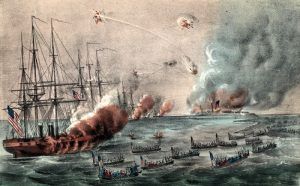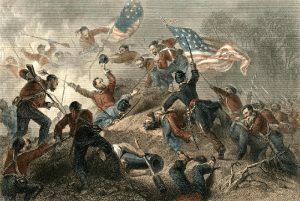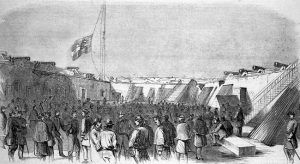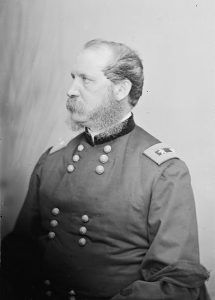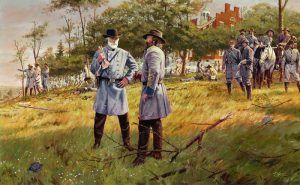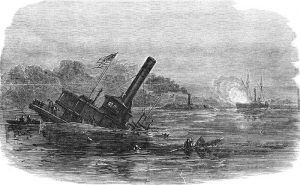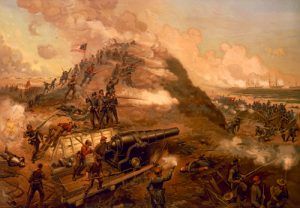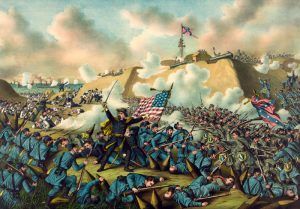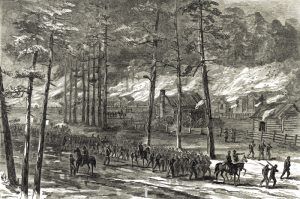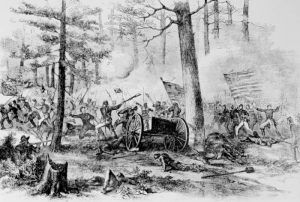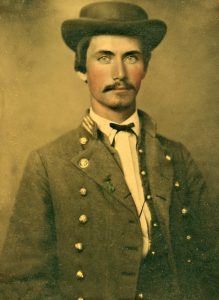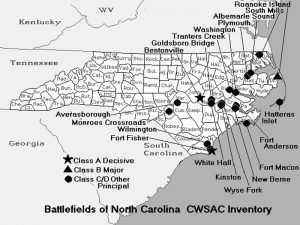 After the Civil War began, North Carolina joined the Confederacy with some reluctance on May 20, 1861. It was the second-to-last state to leave the Union. The reluctance stemmed because its population was divided in their loyalties between the North and the South and remained divided throughout the war. While seven states seceded as a direct result of Abraham Lincoln’s presidential election, North Carolina joined Virginia, Tennessee, and Arkansas in initially choosing to remain within the Union. However, after Confederate forces in Charleston, South Carolina, fired on the Federal garrison at Fort Sumter in April 1861, North Carolina’s position changed and opted to become one of the eleven states of the Confederacy rather than fight against its neighboring states.
After the Civil War began, North Carolina joined the Confederacy with some reluctance on May 20, 1861. It was the second-to-last state to leave the Union. The reluctance stemmed because its population was divided in their loyalties between the North and the South and remained divided throughout the war. While seven states seceded as a direct result of Abraham Lincoln’s presidential election, North Carolina joined Virginia, Tennessee, and Arkansas in initially choosing to remain within the Union. However, after Confederate forces in Charleston, South Carolina, fired on the Federal garrison at Fort Sumter in April 1861, North Carolina’s position changed and opted to become one of the eleven states of the Confederacy rather than fight against its neighboring states.
During the war, of the approximately 150,000 white men in North Carolina between the ages of 15 and 49 — almost 125,000 (or more than 80%) served in the Confederate Army at some point. However, some 24,000 of these men deserted their military units. Between 33,000 and 35,000 died in battle of wounds or disease between 1861 and 1865. Meanwhile, at least 10,000 white and an additional 5,000 black North Carolinians joined Union army units and fought against the Confederacy. Thousands more North Carolinians refused to be conscripted into Confederate military service or to support the state’s war effort by paying taxes or contributing material.
Tensions between Unionists and Confederate forces in North Carolina culminated in two mass killings. The first occurred in late January or early February of 1863 in Madison County when members of the 64th North Carolina infantry killed 13 citizens who were suspected of being Unionists and deserters from the Confederate Army. A year later, in February 1864, Major General George E. Pickett hanged 22 North Carolinians captured fighting for the Union after they had deserted the Confederacy.
Fighting occurred sporadically in the state beginning in September 1861, when Union Major General Ambrose Burnside set about capturing key ports and cities, notably Roanoke Island and New Bern. In 1864, the Confederates assumed the offensive, temporarily reconquering Plymouth, while the Union army launched several attempts to seize Fort Fisher. One of the last remaining major Confederate armies, under Joseph E. Johnston, surrendered near Bennett Place to Union General William Sherman, who spared North Carolina the destruction he had inflicted on South Carolina.
North Carolina Campaigns & Battles:
Blockade of the Carolina Coast – August-December 1861 – The Union blockade, which included the Blockade of the Carolina Coast, was a naval strategy to prevent the Confederacy from trading. The blockade was proclaimed by President Abraham Lincoln in April 1861 and required the monitoring of more than 3,000 miles of Atlantic and Gulf coastline.
Hatteras Inlet Batteries – August 28-29, 1861 – Also called the Battle of Fort Clark and the Battle of Fort Hatteras, this battle occurred in Dare County on August 28-29, 1861. On August 26, an amphibious expedition led by Major General Benjamin F. Butler and Flag Officer Silas Stringham embarked from Fort Monroe, Virginia, to capture Hatteras Inlet, an important haven for blockade runners. On the 28th, while the navy bombarded Forts Clark and Hatteras, Union troops came ashore and attacked the rear of the Confederate batteries. On August 29, Colonel William F. Martin surrendered the Confederate garrison of 670 men. The Federals lost only one man. Butler returned to Fort Monroe, leaving the captured forts garrisoned. This movement was part of Union efforts to seize coastal enclaves from which to enforce the blockade. The Union victory resulted in three Union casualties and 770 Confederate.
Burnside’s North Carolina Expedition – January-July 1862 – This expedition was a series of engagements fought along the North Carolina Coast between February and June 1862. It was aimed at closing blockade-running ports inside the Outer Banks. The amphibious operation was carried out primarily by New England and North Carolina troops under Brigadier General Ambrose E. Burnside and assisted by the North Atlantic Blockading Squadron under Captain Louis M. Goldsborough.
Roanoke Island – February 7-8, 1862 – Also called the Battle of Fort Huger, this battle took place on February 7-8, 1862, in Dare County as part of Burnside’s North Carolina Expedition. On February 7, 1862, Brigadier General Ambrose E. Burnside landed 7,500 men on the southwestern side of Roanoke Island, North Carolina, in an amphibious operation launched from Fort Monroe, Virginia. The following day, supported by gunboats, the Federals assaulted the Confederate forts on the narrow waist of the island, driving back and out-maneuvering Brigadier General Henry Wise’s outnumbered command. After losing less than 100 men, the Confederate commander on the field, Colonel H.M. Shaw, surrendered about 2,500 soldiers and 32 guns. Burnside had secured an important outpost on the Atlantic Coast, tightening the blockade. The Union victory resulted in total estimated casualties of 2,907, including 37 killed, 214 wounded, and 13 missing from the Union, and 23 killed, 58 wounded, and 500 captured from the Confederates.
New Berne – March 14, 1862 – This battle occurred in Craven County on March 14, 1862. On March 11, 1862, Brigadier General Ambrose E. Burnside’s command embarked from Roanoke Island to rendezvous with Union gunboats at Hatteras Inlet for an expedition against New Berne. On March 13, the fleet sailed up the Neuse River and disembarked infantry on the river’s south bank to approach the New Berne defenses. Brigadier General Lawrence Branch commanded the Confederate defense. On March 14, John G. Foster’s, Jesse Reno’s, and John G. Parke’s brigades attacked along the railroad and, after four hours of fighting, drove the Confederates out of their fortifications. The Federals captured nine forts and 41 heavy guns and occupied a base that they would hold to the end of the war despite several Confederate attempts to recover the town. The Union victory resulted in an estimated total casualties of 1,080.
Fort Macon – March 23-April 26, 1862 – This long battle occurred in Carteret County, North Carolina, between March 23 and April 26, 1862. In late March 1862, Major General Ambrose E. Burnside’s army advanced on Fort Macon, a third-system casemated masonry fort that commanded the channel to Beaufort, 35 miles southeast of New Berne. The Union force invested the fort with siege works and, on April 26, opened an accurate fire on the fort, which soon breached the masonry walls. Within a few hours, the fort’s scarp began to collapse, and the Confederates hoisted a white flag. This action demonstrated the inadequacy of masonry forts against large-bore, rifled artillery. The Union victory resulted in Union casualties of 10 and Confederate casualties of 480.
South Mills – April 19, 1862 – Also called the Battle of Camden, this battle was also part of Burnside’s North Carolina Expedition and took place in Camden County on April 19, 1862. After learning that the Confederates were building ironclads at Norfolk, Major General Ambrose E. Burnside planned an expedition to destroy the Dismal Swamp Canal locks to prevent the transfer of the ships to Albemarle Sound. He entrusted the operation to Brigadier General Jesse Lee Reno’s command, which embarked on transports from Roanoke Island on April 18. By midnight, the convoy reached Elizabeth City and began disembarking troops. On the morning of April 19, Reno marched north on the road to South Mills. At the crossroads a few miles below South Mills, elements of Confederate Colonel Ambrose Wright’s command delayed the Federals until dark. Reno then abandoned the expedition and withdrew to the transports at Elizabeth City during the night. The transports carried Reno’s troops to New Berne, where they arrived on April 22. The inconclusive battle resulted in an estimated total of 150 casualties.
Tranter’s Creek – June 5, 1862 – This battle occurred in Pitt County on June 5, 1862, when Colonel Robert Potter, garrison commander at Washington, North Carolina, ordered a reconnaissance toward Pactolus. The 24th Massachusetts, under Lieutenant Colonel F.A. Osborne, advanced to the bridge over Tranter’s Creek, where it encountered the 44th North Carolina, under Confederate Colonel George Singletary. Unable to force a crossing, Osborne brought his artillery to bear on the mill buildings in which the Confederates were barricaded. Colonel Singletary was killed in the bombardment, and his troops retreated. The Federals did not pursue and returned to their fortifications at Washington. The Union victory resulted in an estimated total of 40 casualties.
Goldsborough Expedition – December 1862 – Also known as Foster’s Raid, the Goldsboro Expedition was a series of battles initiated by Union General John G. Foster from New Bern to Goldsboro, with military objectives of destroying the railroads, depots, and the vital Goldsboro Bridge. The action was designed to disrupt the supply line to the north and support General Ambrose Burnside’s attack at Fredericksburg, Virginia.
Kinston – December 14, 1862 – The first battle of the Goldsborough Expedition; this took place in Lenoir County after a Union expedition led by Brigadier General John G. Foster left New Berne in December to disrupt the Wilmington & Weldon Railroad at Goldsborough. The advance was stubbornly contested by Confederate General Nathan Evans’s Brigade near Kinston Bridge on December 14. However, the Confederates were outnumbered and withdrew north of the Neuse River toward Goldsborough. General Foster continued his movement the next day, taking the River Road south of the Neuse River. The Union victory resulted in an estimated total of 685 casualties.
White Hall – December 16, 1862 – Also called the Battle of White Hall Ferry, this battle occurred in Wayne County, North Carolina, as part of the Goldsborough Expedition. On December 16, 1862, Brigadier General John G. Foster’s Union troops reached White Hall, where Confederate Brigadier General Beverly Robertson’s brigade was holding the north bank of the Neuse River. The Federals demonstrated against the Confederates for much of the day, attempting to fix them in position while the main Union column continued toward the railroad. The inconclusive battle resulted in a total of 150 casualties.
Goldsborough Bridge – December 17, 1862 – This battle occurred in Wayne County, North Carolina, as part of the Goldsborough Expedition. On December 17, 1862, Brigadier General John G. Foster’s expedition reached the railroad near Everettsville and began destroying the tracks north toward the Goldsborough Bridge. Confederate Brigadier General Thomas Clingman’s brigade delayed the advance but could not prevent the bridge’s destruction. His mission accomplished, Foster returned to New Berne, where he arrived on the 20th. The Union victory resulted in an estimated 220 casualties.
Longstreet’s Tidewater Operations – February-May 1863 – In 1863, Lieutenant General James Longstreet was placed in command of the Confederate Department of Virginia and North Carolina. He was given several goals — to protect Richmond, support Robert E. Lee’s Army of Northern Virginia, forage and gather supplies for the Confederate armies, and retake or capture the forts along the Virginia and North Carolina Coast.
Fort Anderson – March 13-15, 1863 – Also called the Battle of Deep Gully, this skirmish occurred in Craven County. When Confederate Lieutenant General James Longstreet took charge of the Department of Virginia and North Carolina on February 25, 1863, he directed Major General D.H. Hill, commander of the North Carolina District, to advance on the Union stronghold of New Berne with about 12,000 men. Major General William H.T. Whiting, who commanded the Wilmington garrison, refused to cooperate. After an initial success at Deep Gully on March 13, Hill marched against the well-entrenched Federals at Fort Anderson on March 14-15. Hill was forced to retire upon the arrival of Union gunboats. The city’s garrison was heavily reinforced, and Hill withdrew to threaten Washington, North Carolina. The Union victory resulted in a total of seven casualties.
Washington – March 30-April 20, 1863 – This battle occurred in Beaufort County when Confederate Major General D.H. Hill moved against the Federal garrison of Washington, North Carolina. By March 30, the town was ringed with fortifications, but the Confederates could not shut off supplies and reinforcements arriving by ship. After a week of confusion and mismanagement, Hill was maneuvered out of his siegeworks by Brigadier General John G. Foster and withdrew on April 15. The inconclusive battle resulted in an estimated casualties of 100.
Operations Against Plymouth – April-May 1864 – While the Confederates were having some recent battlefield successes in Virginia, Confederate General Robert E. Lee sent Brigadier General Robert F. Hoke to North Carolina in April 1864 in an attempt to recapture strategic Southern forts and ports along the coast. Although the campaign was successful, other events soon required Hoke to abandon all military activities and return to Lee’s Army of Northern Virginia. The removal of Hoke’s force and the destruction of the Confederate Ironclad Albemarle allowed both Plymouth and Washington, North Carolina, to fall back into Union hands.
Plymouth – April 17-20, 1864 – In a combined operation with the CSS ram Albemarle, Confederate forces under Major General Robert F. Hoke attacked the Federal garrison at Plymouth on April 17. On April 19, the ram appeared in the river, sinking the Smithfield, damaging the Miami, and driving off the other Union ships supporting the Plymouth garrison. Confederate forces captured Fort Comfort, driving defenders into Fort Williams. On the 20th, the garrison surrendered. The Confederate victory resulted in total estimated casualties of 2,834.
Albemarle Sound – May 5, 1864 – Taking place in Washington County, North Carolina, this battle was part of the Operations against Plymouth Campaign. On May 5, 1864, the Confederate ship Albemarle, commanded by J.W. Cooke, fought seven blockading Union ships to a draw at the mouth of the Roanoke River. Captain Melancton Smith and the Federal troops recaptured the converted steamer Bombshell during the fight, and the USS Sassacus was severely damaged. The inconclusive battle resulted in an estimated 88 total casualties.
Expedition against Fort Fisher – December 1864
Fort Fisher – December 7-27, 1864 – In December 1864, Union Major General Benjamin Butler was relieved of command of the Army of the James and assigned to lead an amphibious expedition against Fort Fisher, North Carolina, which protected Wilmington, the South’s last open seaport on the Atlantic coast. Learning that many Union troops had embarked from Hampton Roads on December 13, Confederate General Robert E. Lee dispatched Major General Robert Hoke’s Division to meet the expected attack on Fort Fisher. On December 24, the Union fleet under Rear Admiral David D. Porter arrived to shell the fort. An infantry division disembarked from transports to test the fort’s defenses. The Federal assault on the fort had already begun when Hoke approached, discouraging further Union attempts. Butler called off the expedition on December 27 and returned to Fort Monroe, Virginia. The Confederate victory resulted in a total estimated casualties of 320.
Operations Against Fort Fisher and Wilmington – January-February 1865
Fort Fisher – January 13-15, 1865 – After his December 1864 expedition failed against Fort Fisher, Union Major General Benjamin Butler was relieved of command. Major General Alfred Terry was then placed in command of a “Provisional Corps,” including Paine’s Division of U.S. Colored Troops, and supported by a naval force of nearly 60 vessels to renew operations against the fort. After a preliminary bombardment directed by Rear Admiral David D. Porter on January 13, Union forces landed and prepared an attack on Confederate Major General Robert Hoke’s infantry line. On January 15, a select force moved on the fort from the rear. Following the bloody repulse of a naval landing party, a bold attack late in the afternoon carried the parapet. The Confederate garrison surrendered, opening the way for a Federal thrust against Wilmington, the South’s last open seaport on the Atlantic coast. The Union victory resulted in an estimated total casualties of 2,000.
Wilmington – February 12-22, 1865 – Also known as the Battle of Fort Anderson, Town Creek, Forks Road, and Sugar Loaf Hill, this confrontation occurred in New Hanover County. Wilmington’s days were numbered from the fall of Fort Fisher to Major General Alfred Terry and Rear Admiral David Porter’s combined operation on January 15. About 6,600 Confederate troops under Major General Robert Hoke held Fort Anderson and a line of works that prevented the Federals from advancing up the Cape Fear River. In early February, the XXIII Corps arrived at Fort Fisher, and Major General John Schofield commanded the Union forces. Schofield began a series of maneuvers to force the Confederates to abandon their defenses. On February 16, 1865, Jacob Cox’s division ferried across the river to confront Fort Anderson while Porter’s gunboats bombarded the fort. On February 17-18, Ames’s division conducted a wide flanking march to get in the fort’s rear. Seeing the trap ready to close, the Confederates evacuated Fort Anderson during the night of the 18th-19th, withdrawing to Town Creek to form a new defensive line. The next day, this line collapsed due to increasing Federal pressures. During the night of February 21-22, General Braxton Bragg ordered the evacuation of Wilmington, burning cotton, tobacco, and government stores. The Union victory resulted in an estimated total of 1,150 casualties.
Campaign of the Carolinas – February-April 1865 – The Carolinas Campaign was the final Western Theater of the Civil War campaign. During February-April 1865, Union Major General William Tecumseh Sherman advanced north from Savannah, Georgia, through South Carolina and North Carolina to link up with Union forces in Virginia. The defeat of Confederate General Joseph E. Johnston’s army at the Battle of Bentonville, North Carolina, in March and its surrender in April 1865 represented the loss of the final major army of the Confederacy.
Wyse Fork – March 7-10, 1865 – Also called the Battle of Wilcox’s Bridge, Wise’s Fork, Second Kinston, Second Southwest Creek, and Kelly’s Mill Pond, this large battle, which included about 20,500 soldiers, took place in Lenoir County, North Carolina. in February 1865, Union Major General John Schofield planned to advance inland from Wilmington, at the same time assigning Major General Jacob Cox to direct Union forces from New Berne toward Goldsboro. On March 7, Cox’s advance was stopped by Confederate Major General Robert Hoke’s and Johnson Hagood’s divisions under General Braxton Bragg’s command at Southwest Creek below Kinston. On March 8, the Confederates attempted to seize the initiative by attacking the Union flanks. After initial success, the Confederate attacks stalled because of faulty communications. On March 9, the Union forces were reinforced and beat back Bragg’s renewed attacks on May 10 after heavy fighting. Bragg withdrew across the Neuse River and could not prevent Kinston’s fall on March 14. The Union victory resulted in estimated Union casualties of 1,101 and Confederate casualties of 1,500.
Monroe’s Cross – March 10, 1865 – Also called the Battle of Fayetteville Road and Blue’s Farm, this battle occurred in Hoke County. As Union General William Sherman’s army advanced into North Carolina, Brigadier General Judson Kilpatrick’s Cavalry Division screened its left flank. On the evening of March 9, 1865, two of Kilpatrick’s brigades encamped near the Charles Monroe House in Hoke County. Early on March 10, Confederate cavalry under the command of Lieutenant General Wade Hampton surprised the Federals in their camps, driving them back in confusion and capturing wagons and artillery. The Federals regrouped and counterattacked, regaining their artillery and camps after a desperate fight. With Union reinforcements on the way, the Confederates withdrew. The inconclusive battle resulted in estimated casualties of 183 Union and 86 Confederate.
Averasborough – March 16, 1865 – Also called the Battle of Taylor’s Hole Creek, Smithville, Smiths Ferry, or Black River, this battle occurred on March 16, 1865, in Harnett and Cumberland Counties. On the afternoon of March 15, 1865, Brigadier General Judson Kilpatrick’s cavalry came up against Lieutenant General William Hardee’s corps — consisting of Taliaferro’s and McLaw’s infantry divisions and Wheeler’s dismounted cavalry — deployed across Raleigh Road near Smithville. After feeling out the Confederate defenses, Kilpatrick withdrew and called for infantry support. During the night, four divisions of the XX Corps arrived to confront the Confederates. At dawn, March 16, the Federals advanced on a division front, driving back skirmishers, but the main Confederate line and a counterattack stopped them. Mid-morning, the Federals renewed their advance with strong reinforcements and drove the Confederates from two lines of work, but they were repulsed at a third line. Late afternoon, the Union XIV Corps began to arrive on the field but could not deploy before dark due to the swampy ground. Hardee retreated during the night after holding up the Union advance for nearly two days. The inconclusive battle resulted in an estimated total casualties of 1,419.
Bentonville – March 19-21, 1865 – This battle occurred in Johnston County, North Carolina, March 19-21, 1865, as part of the Campaign of the Carolinas. While Union Major General Henry Slocum’s advance was stalled at Averasborough by Confederate Lieutenant General William Hardee’s troops, the right wing of Union Major General William T. Sherman’s army was under the command of Major General O.O. Howard marched toward Goldsborough. On March 19, Slocum encountered the entrenched Confederates of General Joseph E. Johnston, who had concentrated on meeting his advance at Bentonville. In the late afternoon, Johnston attacked, crushing the line of the XIV Corps. Only strong counterattacks and desperate fighting south of the Goldsborough Road blunted the Confederate offensive. Elements of the XX Corps were thrown into action as they arrived on the field. Five Confederate attacks failed to dislodge the Federal defenders, and darkness ended the first day of fighting. During the night, Johnston contracted his line into a “V” to protect his flanks with Mill Creek to his rear. On March 20, Slocum was heavily reinforced, but fighting was sporadic. Sherman was inclined to let Johnston retreat. On March 21, however, Johnston remained in position while he removed his wounded and skirmishing heated up along the entire front. In the afternoon, Major General Joseph Mower led his Union division along a narrow trace that carried it across Mill Creek into Johnston’s rear. Confederate counterattacks stopped Mower’s advance, saving the army’s only line of communication and retreat. Mower then withdrew, ending fighting for the day. During the night, Johnston retreated across the bridge at Bentonville. Union forces pursued at first light, driving back Wheeler’s rearguard and saving the bridge. The Federal pursuit was halted at Hannah’s Creek after a severe skirmish. Sherman, after regrouping at Goldsborough, pursued Johnston toward Raleigh. On April 18, Johnston signed an armistice with Sherman at the Bennett House, and on April 26, he formally surrendered his army. The Union victory resulted in estimated casualties of 1,646 Union and 3,092 Confederate.
Compiled by Kathy Alexander/Legends of America, updated January 2024.
Also See:
Sources:

